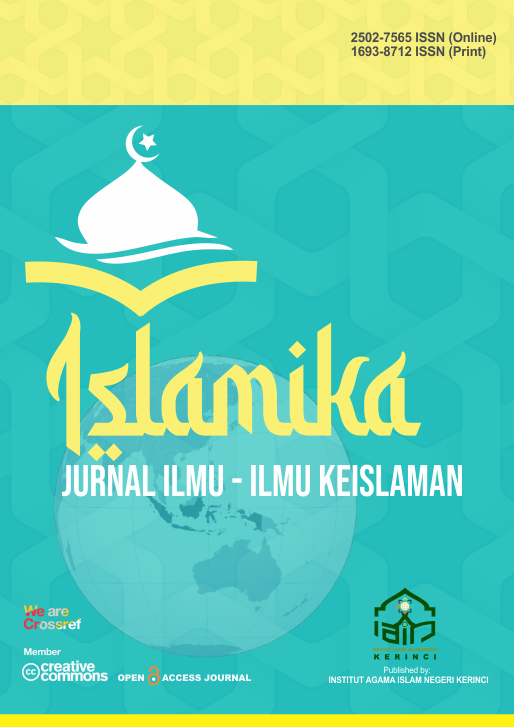Living Islam: Tradisi Menyambangi Rumah Ulama Dalam Idulfitri
DOI:
https://doi.org/10.32939/islamika.v22i2.1469Keywords:
living, islam, ulama, idul fitriAbstract
Abstract: this article examines the phenomenon of Living Islam in Eid al-Fitr with special reference to the people of Koto Padang Village, Sungaipenuh. It explains how the diversity of Islamic practices in local communities is influenced by differences in responses to the function of the scriptures and the local context surrounding them. It looks at how the reception of the local Islamic community towards the holy book and the pattern of interaction between religion and local culture in the tradition of visiting ulama’ houses. The function of the scriptures in history is not singular. Sources of Islamic teachings, apart from being interpreted in order to obtain the message and meaning in them (informative function), are also often understood to be actualized in concrete action (perfomative function). The comprehension process is also influenced by the local context and the situation of the reader. Based on religious and sociological studies, this paper finds that the tradition of visiting the ulamas house is one of the forms of the performing function of the scripture in the local community. The inteaction of religious understanding regarding Eid al-Fitr and respect for ulama with local culture has resulted in the practice of visiting ulamas’ houses during Eid al-Fitr. Nevertheless, this practice shows that the role of religion in influencing culture is more dominant. The values found in this tradition are this practice is a means of maintaining religious and cultural identity, respecting the ulama and moral education for the younger generation, praying as a form of good endeavor, enlivening Eid al-Fitr and fostering social cohesion
Downloads
References
Aini, B. al-D. al-. (2010). ‘Umdah al-Qari Syarh Shahih al-Bukhari (Vol. 6). Dar al-Fikr.
Ali, M. (2011). Muslim diversity: Islam and local tradition in Java and Sulawesi, Indonesia. Indonesian Journal of Islam and Muslim Societies, 1(1), 1–35.
Ananda, R. R. (2019). Analysis Abnormal Return Eid Al-Fitr on Food and Beverages Company Listed In Indonesia Stock Exchange Year 2013–2017. Journal of Economics, Business, and Government Challenges, 2(1), 79–85.
BBC. (2019, Mei). How is Eid al-Fitr Celebrated Around the World? BBC. https://www.bbc.co.uk/bitesize/articles/z4cmkmn
Doak, R. (2009). Empire of the Islamic World. Chelsea House. https://books.google.co.id/books?id=EaoJ-BorltMC
Durkheim, E. (2016). The elementary forms of religious life. Dalam Social Theory Re-Wired (hlm. 52–67). Routledge.
Frontiers, M. W. N. (2007). Discover Islamic Art in the Mediterranean. Museum With No Frontiers. https://books.google.co.id/books?id=gA3dSlLBG38C
Gadamer, H.-G. (2013). Truth and method. A&C Black.
Hakam, S. (2015). Halal Bi Halal, A Festival Of Idul Fitri And It’s Relation With The History Of Islamization In Java. Epistemé: Jurnal Pengembangan Ilmu Keislaman, 10(2), 385–404.
Harari, M. A. al. (2019). Syarah Sunan Ibn Majah (1 ed., Vol. 8). Dar al-Manhaj.
Hurd, E. S. (2015). Beyond religious freedom. Dalam Beyond Religious Freedom. Princeton University Press.
Idris, J., Rowley, C., & Yaqub, M. J. (t.t.). Religious events: Celebrating Eid-al-Fitr as a family. Dalam Family Events (hlm. 117–129). Routledge.
Iriany, I. S., Pasciana, R., & Ramdhani, A. (2019). Eid homecoming" Mudik" tradition as a conventional pattern in the global era. Journal of Advanced Research in Social Sciences and Humanities, 4(3), 129–135.
Ityubi, M. I. A. I. A. M. al-. (2015). Al-Bahrul Muhith al-Tsajaj fi Syarhi Shahih al-Imam Muslim al-Hajjaj (1 ed., Vol. 17). Dar Ibn al Jauzi.
McGowan Jr, C. B., & Jakob, N. A. (2010). Is there an Eid al-Fitr effect in Malaysia? International Business & Economics Research Journal (IBER), 9(4).
Miles, M. B., Huberman, A. M., & Saldaña, J. (2018). Qualitative data analysis: A methods sourcebook. Sage publications.
Qadhi Ali al-. (2017). Ma’arik Ramadaniyah Fasilah Fi Tarikh al-Islam . Wakalat al-Shihafah al-’Arabiyah.
Rafiq, A. (2021). The Living Qur’an: Its Text and Practice in the Function of the Scripture. Jurnal Studi Ilmu-Ilmu Al-Qur’an Dan Hadis, 22(2), 469–484.
Rianti, A., Novenia, A. E., Christopher, A., Lestari, D., & Parassih, E. K. (2018). Ketupat as traditional food of Indonesian culture. Journal of Ethnic Foods, 5(1), 4–9.
Rusdianto, A. S., & Busro, B. (2022). Takbiran Carnival Tradition in Welcoming Eid Al-Fitr During a Pandemic. Gunung Djati Conference Series, 11, 69–82.
Scharf, B. R. (1972). The sociological study of religion. Religious Studies, 8(2).
Sulaiman, A. al-W. (2010). Al-Muntaqa Syarhu al-Muwatha’ (1 ed., Vol. 1). Matba’ah al-Sa’adah.
Yurike, S., & Sukamulja, S. (2014). Eid Al-Fitr Holiday Effect and The Relation Between Eid Al-Fitr Holiday Effect with The Firm Size During 2000 to 2013. Jurnal Ekonomi Manajemen Internasional, 53, 1–12.
Downloads
Published
How to Cite
Issue
Section
License
Copyright (c) 2022 Rahmat Fauzi

This work is licensed under a Creative Commons Attribution-ShareAlike 4.0 International License.










